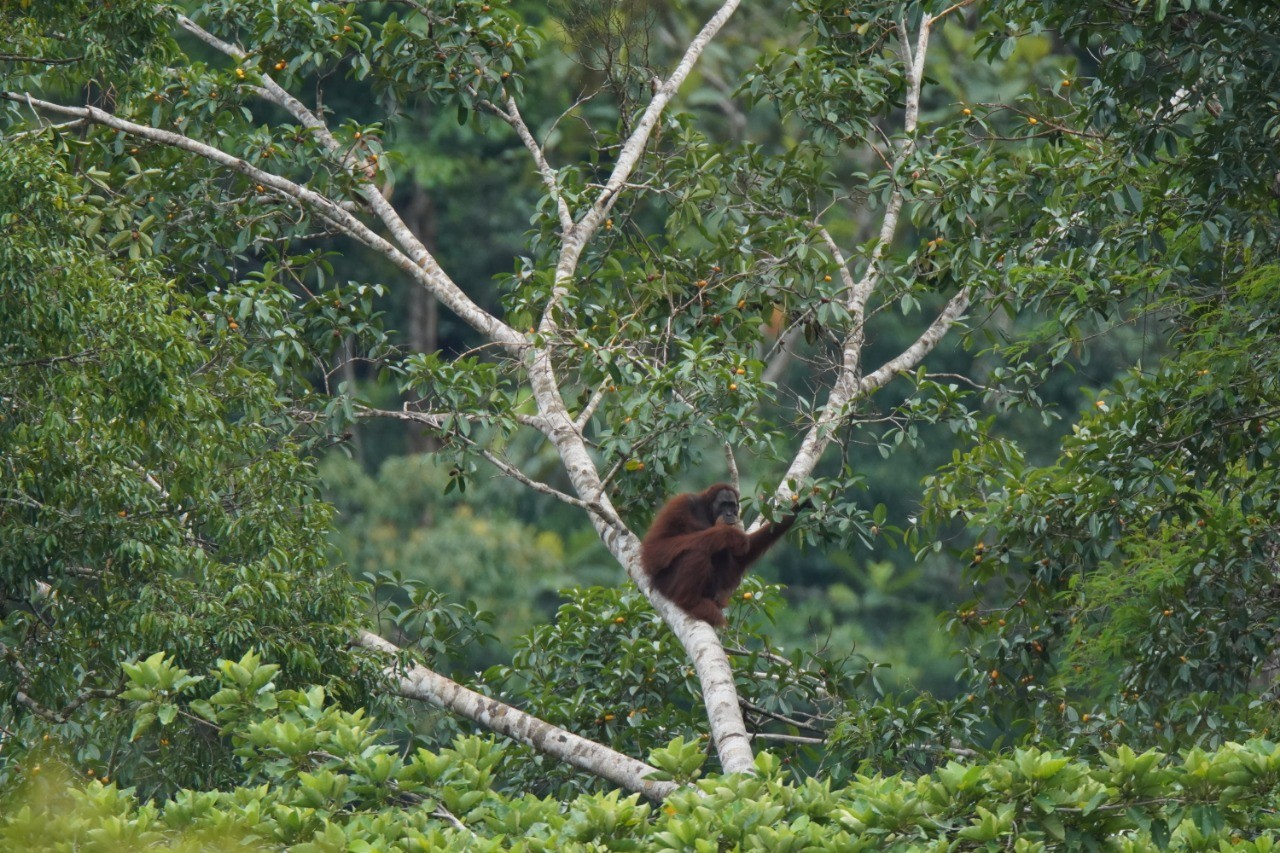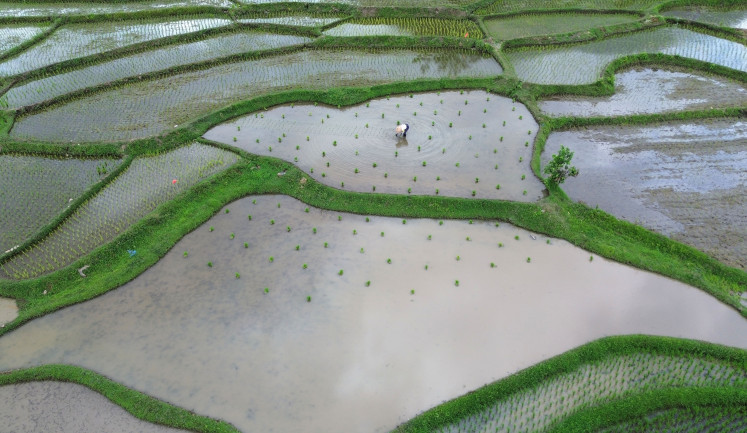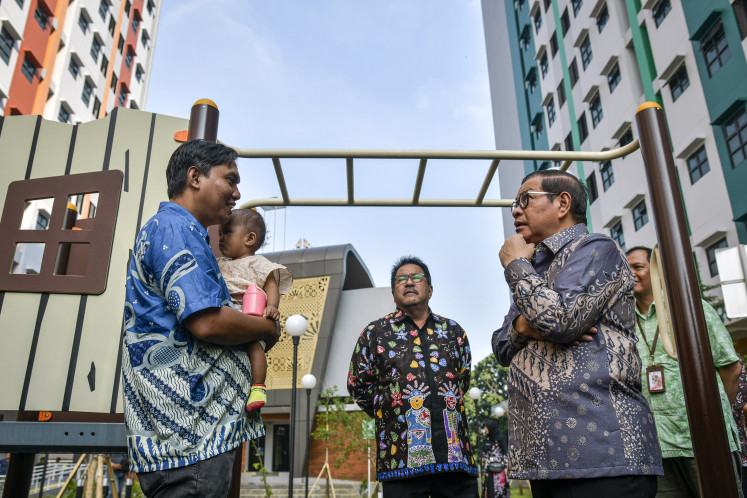Popular Reads
Top Results
Can't find what you're looking for?
View all search resultsPopular Reads
Top Results
Can't find what you're looking for?
View all search resultsOrwellian doublespeak clouds discussion over ape and dam
As pointed out in the fact check report and elsewhere, conducting research on orangutans while disturbances are actively ongoing cannot generate baseline insights into population dynamics, and therefore is not a valid basis on which to determine mitigation or avoidance measures.
Change text size
Gift Premium Articles
to Anyone
I
n her recent commentary on the Batang Toru hydro project and the critically endangered Tapanuli orangutan, Emmy Hafild attempts to obfuscate the ongoing debate on apes and dams with the oddly titled article “collaborative sustainable management of other use areas”.
The “other use areas” Hafild refers to are land areas outside the forest estate, named Areal Penggunaan Lain (APL), which are mostly topographically flat areas suitable for agricultural production. For 10 years, dedicated conservationists from both Indonesia and abroad worked hard to get the Batang Toru ecosystem protected, and they succeeded in getting most orangutan habitat incorporated into protection forests, but strangely not the steep forested part that is now classified as “other use area” despite environmental laws indicating it qualifies for protection. It looks like this area was already earmarked for “another use”.
Unfortunately, this “other use area” happens to have the highest orangutan densities in the entire region. This is not something “Serge Wich claims”, as stated by Hafild, but was established by rigorous studies in 2015 funded by the International Finance Corporation.
Hafild has taken umbrage at a Fact Check report published by the IUCN, which identifies several public claims made by PT NSHE in relation to the Batang Toru hydro project as being inaccurate or misleading. A quote from Hafild’s latest article that deserves special attention is that: "I have found the fact check has a fundamental problem because it was based on wrong and outdated information. PT NSHE has done more work and studies since construction started, and new data and information has changed some of the previous position."
The key phrase here is “since construction started”. Hafild now claims that “orangutans inhabiting APL are mostly in low to moderate density” in the area where the dam is being developed. Given that this area has been an active construction site for a few years, it is hardly surprising that some orangutans may have fled the disturbance. The logging, blasting and excavation has certainly led to the displacement of orangutans from this core part of their habitat, as evidenced last year when a displaced orangutan was almost beaten to death by local villagers.
As pointed out in the fact check report and elsewhere, conducting research on orangutans while disturbances are actively ongoing cannot generate baseline insights into population dynamics, and therefore is not a valid basis on which to determine mitigation or avoidance measures. The “new data” that Hafild refers to does not invalidate previous studies that identified the area where construction is taking place as a core habitat zone for the Tapanuli orangutan, with higher densities than anywhere else in the whole ecosystem.
Why does this all matter? Population trend and viability analyses indicate that the dam and associated infrastructure, as currently designed, will rapidly increase the speed at which the Tapanuli orangutan is declining. This decline has recently been demonstrated, for example, in the Hopong forest, mostly due to human activities.
Looking at the historic range of the Tapanuli orangutan, sources reveal that 100 years ago the species occurred in a much larger area, and that currently about 10 to 20 percent of the former habitat remains. The species disappeared from large areas of the landscape a long time before commercial exploitation of forests started and the most likely reason why orangutan populations became locally extinct is that they were hunted and killed at greater rates than the population could withstand.
Orangutan population modelling indicates that in most habitats an annual killing rate of 1 percent means that the population will become extinct. Basically, if every year you take more than one animal out of a population of 100, that population will go extinct. The entire Tapanuli orangutan species numbers fewer than 800 individuals, split across three subpopulations. It therefore follows that if 8 or more orangutans are lost each year, the species will spiral into extinction. This is the most endangered great ape species in the world, and with such precariously low numbers surviving, every life, and every square meter of habitat, is precious and must be protected.
By developing a zone of disturbance in the only area of connectivity between the three subpopulations of the Tapanuli orangutan, the company would be responsible for stopping any genetic flow that might still occur. This basically means that the main population of about 580 animals in the west block of forest will lose the connection with the 24 individuals in the Sibual-buali Reserve, and probably also the connections with the 162 individuals in the east block. In other words, these two smaller populations (making up 24 percent of the remaining wild individuals) will be condemned to functional extinction. Such loses would also endanger the viability of the remaining orangutans in the west block and could thus condemn the species to extinction. This doesn’t even include the orangutans that have been displaced from the construction site, some of which are now likely dead or in captivity.
For all the nice words about “collaborative sustainable management by the local governments of North, Central and South Tapanuli”, Hafild is clear in saying that this management is “intended for economic purposes.”
So, Hafild’s claim that “the sustainable development principles will treat economic, environmental and social dimensions in an equilibrium, so that there is no dichotomy between conservation and economy”, is simply Orwellian. It makes gigantic unrealistic promises that are neither in line with Indonesia’s conservation laws that state that protected species cannot be harmed, nor with science that shows that orangutans are hanging by a thread and can very easily be pushed over the edge into extinction.
The Indonesian government recognizes the extreme risks to the survival of the Tapanuli orangutan. The latest Population and Habitat Viability Assessment (PHVA), published in 2019 by the Environment and Forestry Ministry, identifies hydroelectric infrastructure as a main threat to the species, and one of the recommended priority conservation strategies is the “halting of all current development projects, especially the hydrodam and developing roads”.
The International Union for the Conservation of Nature, of which the Indonesian conservation authorities are a member, has also called for a moratorium on the project. It did not call for a project cancellation but for a time of debate and contemplation in which conservation and social experts can work with project planners and government to determine whether this project could be implemented without negatively impacting the Tapanuli orangutan and causing its extinction.
The fact that the hydrodam company is nevertheless pushing ahead, ignoring the recommendations of the government’s PHVA and the IUCN, can only mean that ultimately, they are deepening the dichotomy between conservation and economy, despite greenwashing efforts to the contrary.
Finally, we note that Hafild’s claim to be an “independent environment observer”, as stated in the original version of her latest opinion piece, is deeply disingenuous. She has in fact advised the president of PT North Sumatera Hydro Energy, the company behind the Batang Toru dam.
***
The authors have experience in orangutan conservation science and practice. Onrizal works for the School of Forestry, North Sumatra University (USU), Medan; Nurcahyo is an independent scientist; Serge Wich works for Liverpool John Moores University, UK; and Erik Meijaard works for Borneo Futures, Brunei. They declare no conflict of interest.










